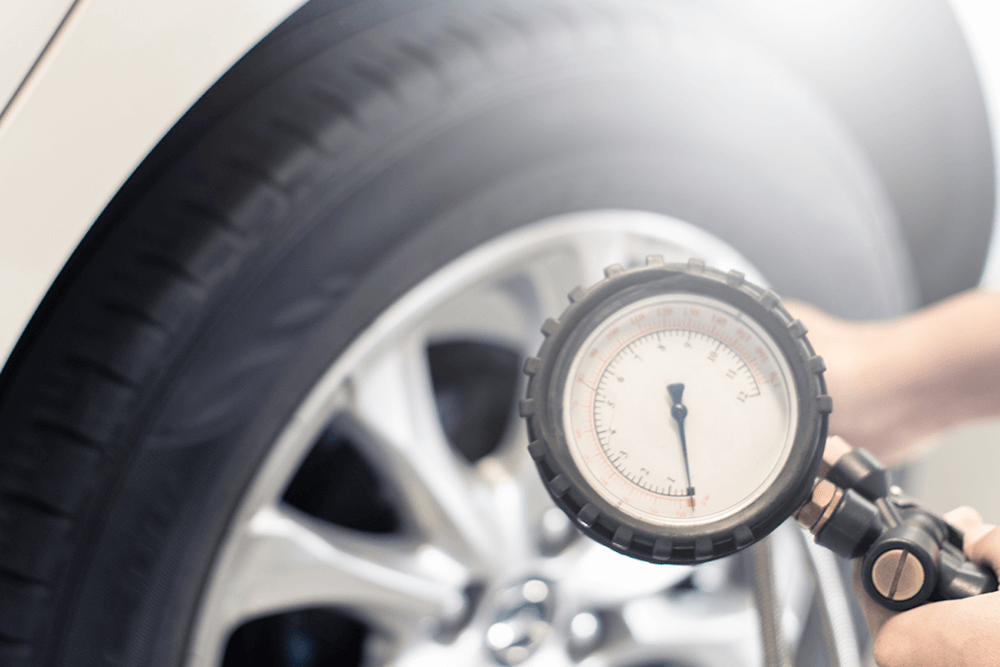From a safety and cost standpoint, tire maintenance is one of the most important things you can do for your car. The easiest way to care for your tires is both quick and inexpensive: maintain the correct tire pressure.
The recommended pressure for tires varies by the type of car and tire. Because maintaining your tires is so crucial to your safety and your car’s overall performance, it’s important to know what tire pressure is correct for your vehicle.
To learn what your tire pressure should be, look for your manufacturer’s recommendation, which is printed on a label inside your car. Depending on the vehicle, this label may be on the edge of the vehicle’s door, on the doorpost or in the glove box. The label will usually give recommendations for the front and rear tires as well as the spare, and it’s important that you stick to those guidelines. Even after you’ve replaced your tires, the same pressure guidelines on your car’s label apply to new tires of the same size.
Pressure recommendations are based on readings taken from a tire pressure gauge. Check the pressure first thing in the morning or wait at least three hours after driving; this provides sufficient time for them to cool back down.1
Driving on underinflated tires is one of the biggest causes of tire failure, according to the National Highway Traffic Safety Administration. And not having enough air in your tires can lead to other problems. Under-inflated tires wear out more rapidly, handle poorly and reduce fuel efficiency. On the other hand, overinflated tires are more susceptible to damage from road irregularities, and they also result in a bumpier ride. Overfilling your tires is just as dangerous as underfilling them, so it’s important you know what is recommended for your vehicle.
Knowing how to check tire pressure is critical to your safety and to keeping your tires in good working order.
When it comes to choosing a gauge, you typically have 3 options:
Put the pressure gauge into the valve stem, making sure the gauge is evenly and firmly pressed onto the stem. If you’re using a pen-style gauge, read the number on the rod that pops out of the sleeve. Read dial pressure gauges as you would a watch with one hand. With a digital pressure gauge, simply read the number on the screen. 2
Find your tires’ recommended PSI in the owner’s manual or on a sticker just inside the driver’s side door. The proper PSI is crucial to your safety and the car’s longevity. Underinflated tires can overheat and wear unevenly; overinflated tires can blow out.1
Underinflated tires can overheat and wear unevenly; overinflated tires can blow out.1
Temperature has a direct effect on your air tires’ air pressure, so for an accurate PSI reading, make sure to check tire pressure when tires are cold. If it’s cold outside, then you can assume your tires are losing PSI and you should check even more frequently. This will help to ensure maximum safety. Take your car to a mechanic you trust for a professional assessment.3
If you happen to find yourself without a tire gauge and your car doesn’t have an indicator for low tire pressure, there are several things you can do to figure out whether your tires need to be inflated.

Of course, knowing your recommended PSI isn’t enough. You have to ensure you’re checking your tires regularly. Experts recommend you check air pressure once a month.5 Your car’s tire pressure monitoring system TPMS measures the amount of air in your tires to let you know whether your tires are properly inflated.1
Frequently checking your PSI becomes even more important in the fall and winter, when outside temperatures drop and weather conditions fluctuate causing your tires to lose air more quickly. Generally, your tire will gain or lose 1 PSI for every 10-degree change in temperature, which means if you have a sudden drop of 30 degrees, you could lose 3 PSI overnight.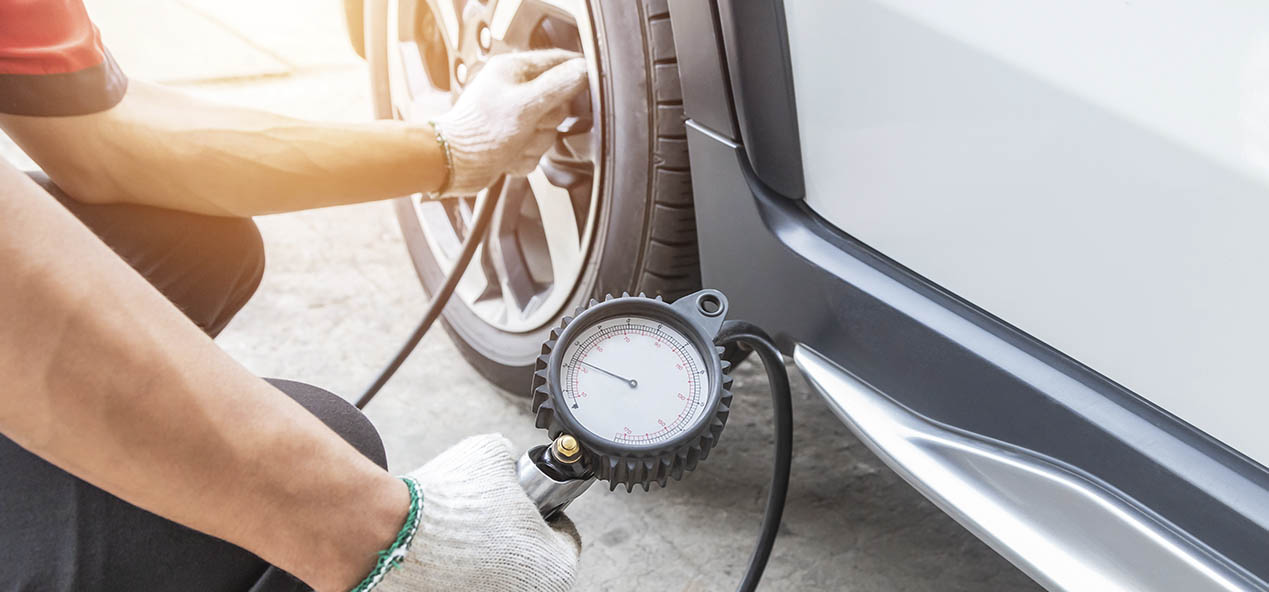 If your tires were already low, this could cause tire damage, steering problems or even a flat tire.
3
If your tires were already low, this could cause tire damage, steering problems or even a flat tire.
3
Knowing and maintaining the right air pressure is important to the safety and longevity of your tires. All it takes is a tire pressure gauge and a few minutes of your time.
Once you have the right tire pressure, make sure you also have the right coverage. Learn more about how Nationwide auto insurance can help protect you and save you money.
Sources:
1 https://www.pirelli.com/tires/en-us/car/driving-and-tire-tips/how-to-read/recommended-tire-pressure, Accessed April 2022.
2 https://www.consumerreports.org/cro/tire-pressure-gauges/buying-guide/index.htm#:~:text=There%20are%20three%20types%20of,of%205%20to%2099%20psi., Accessed April 2022.
3 https://www.firestonecompleteautocare.com/blog/tires/should-i-inflate-tires-cold-weather/, Accessed April 2022.
4 https://rxmechanic.com/how-to-check-tire-pressure-without-gauge/, Accessed February 2022.
Maintaining correct tire inflation pressure is very important since it helps optimize tire performance and fuel economy while over-inflated tires are just as problematic as under-inflated ones.
In fact, driving with under-inflated tires is one of the biggest causes of tire failure, according to the National Highway Traffic Safety Administration.
Besides, under-inflated tires can cause many other problems such as wearing out more rapidly, handling poorly and reducing fuel efficiency.
In addition, over-inflated tires are more susceptible to damage from road irregularities, and this also creates a bumpier ride.
Overfilling your tires is just as dangerous as under-filling them, so it’s important you know what is recommended for your vehicle.
This article will give you everything that you need know about your recommended tire pressure. These include:
Buy Pressure Gauge at Amazon
Recommended tire pressure, where to find it?Since tire pressure is so important to your safety and your car’s overall performance, it is important to know which level of tire pressure is right for your vehicle.
In fact, how much air pressure your tires need depends on several factors, including the type of vehicle, the type of tire and the intended use of the vehicle etc.
Air pressure in tires is measured in pounds per square inch or PSI. You can find your tire pressure both inside your car and on the sidewall of the tire.
How to find recommended tire pressure inside your carYou could find the manufacturer’s optimum or recommended tire pressure for your car on a sticker in the door jam, or in your owner’s manual. Some car models even place the stickers on the trunk lid, in the console or on the fuel door. For best results, look for a placard on the inside of the driver’s door, like the example in the photo below.
How to find maximum tire pressure on the sidewall of your tiresSomewhere on the sidewall of your tire, just below the big, bold letters of the manufacturer, for example, you might have noticed the words ‘Max. Press. 35 PSI.’ (pounds per square inch).
Press. 35 PSI.’ (pounds per square inch).
That number tells you the maximum cold pressure needed for your tire to carry its maximum load.
Most typical tires require about 32 to 35 pounds per square inch (PSI) of air, says Rod Tate, owner of highly rated Colony One Auto Center in Stafford, Texas.
Large trucks require much larger tires with PSIs of 50 to 60. Heavy-duty vehicles can go even higher. For example, tire in the picture below requires 41 pounds per square inch of air.
However, the tire’s maximum pressure is NOT necessarily the most suitable pressure for every vehicle upon which the tire can be used (almost all vehicle manufacturers’ recommended tire inflation pressures are less than the tires’ maximum pressure).
You really should follow the recommended pressure printed somewhere inside your car or in the manual rather than the maximum pressure. In the next section, I will explain why.
Buy Pressure Gauge at Amazon
Why is maximum tire pressure not the best?If you insist on inflating your tires to the max PSI, there will be more likely that two things below will happen
Since tires inflated to the max cannot give as much on the sidewall, you might see superior cornering, but it could be at the risk of your braking threshold. One quick corner and your back end could slide out.
One quick corner and your back end could slide out.
When your tires are inflated too much, the rubber rounds out at the top of the tire when you are driving, and the center will quickly wear out. You will also reduce your traction and you could even cause a blowout.
Therefore, maximum pressure is not the best, rather, recommended pressure is. I need to repeat here that the pressure listed on the sidewall is a maximum pressure only, but not a recommended pressure. Instead, you should use the air pressure recommended in the vehicle’s owner’s manual or tire information placard label.
How to check your tires pressure?Therefore, maximum pressure is not the best, rather, recommended pressure is. I need to repeat here that the pressure listed on the sidewall is a maximum pressure only, but not a recommended pressure. Instead, you should use the air pressure recommended in the vehicle’s owner’s manual or tire information placard label.
Instead, you should use the air pressure recommended in the vehicle’s owner’s manual or tire information placard label.
After knowing the most appropriate pressure for your car tires, you should check whether your tires have such pressure. In addition, checking the pressure of your tires regularly is one of the most important – and most often overlooked – regular maintenance that you should do to ensure your safety and quality of your driving. Monitoring the amount of air in your tires will let you know if you have a small leak and can help you avoid an unexpected flat tire.
Frequently checking your PSI becomes even more important in the fall and winter, when outside temperatures drop and weather conditions fluctuate causing your tires to lose air more quickly. Generally speaking, your tire will gain or lose one PSI for every 10-degree change in temperature, which means if you have a sudden drop of 30 degrees, you could lose three PSI overnight. If your tires were already low, this could cause tire damage, steering problems or even a flat tire.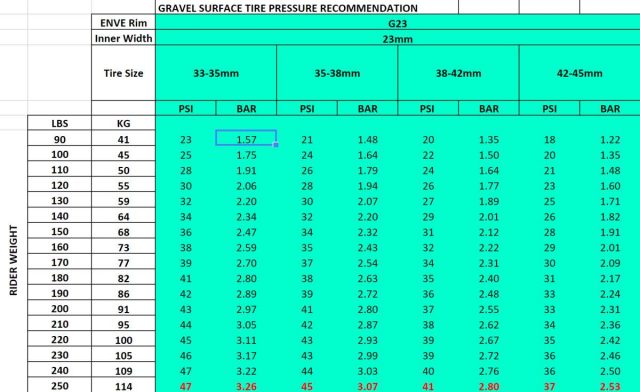
Some experts recommend that you should check the air pressure every time you refuel; others say once a month is sufficient.
How to check tire pressure properly? Checking tire pressure is easy. You can do it right at home or at the gas station. Just be sure you check the pressure when your tires are cold, or have not been driven in several hours. This will give you the most accurate reading.
The most important piece of equipment you need is an accurate tire pressure gauge. You can find battery-operated digital gauges, or more traditional stick-type gauge found at most gas stations. A good gauge should not set you back more than $15 – a worthwhile investment for a longer life for your tires.
Buy Pressure Gauge at Amazon
Make sure you have your manufacturer’s PSI handy when you are checking your tire pressure, and then follow these steps:

By checking tire pressure once a month, you will get a good idea how they are performing. If your tires are fairly new and continue to leak air, you should consult your dealer or mechanic. You may have a faulty valve or other damage that is difficult to detect which could unfortunately result in the need to replace the tires completely.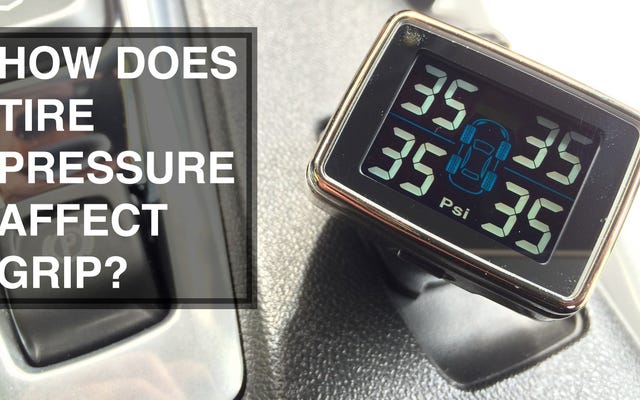 But with proactive maintenance, you could catch an issue before it becomes a problem, and just end up needing a small repair.
But with proactive maintenance, you could catch an issue before it becomes a problem, and just end up needing a small repair.
Often, it is hard to spot an under-inflated tire until it is too late – in other words, it is completely flat. Of course, you could carry a gauge around at all times to measure the pressure, but that is not exactly convenient. Instead, watch for these signs and symptoms of tires that are under-inflated.
When your tires are under-inflated, your ride can be less smooth than usual. You may even find that it takes longer to brake.
When a tire is not inflated properly, it wears down more quickly. If you notice that one or all of your tires are wearing out faster than usual, it may be because they are under-inflated.
Tires that are under-inflated can make your vehicle quiver and shake, which is not a pleasant driving experience.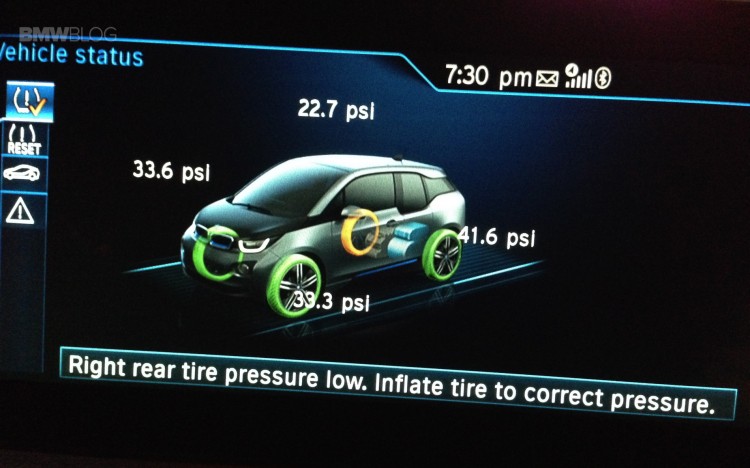 Under-inflation can even cause tires to become misaligned, with comes with it is own variety of problems.
Under-inflation can even cause tires to become misaligned, with comes with it is own variety of problems.
These are all things that you need to know about recommended pressures of your car tires. After reading this article, you will never confuse about the right pressure of your tires and will know how to check it.
Please share your ideas with me if you have other tips for this.
Tire pressure significantly affects driving parameters: comfort, car handling, economy and safety. It is important to maintain the pressure recommended by the manufacturer and check it regularly. Let's figure out how to do it right.
When driving on asphalt, incorrect tire pressure (both high and low) leads to a decrease in the contact patch with the road. An overinflated wheel clings to the surface only in the central part, which leads to its rapid wear.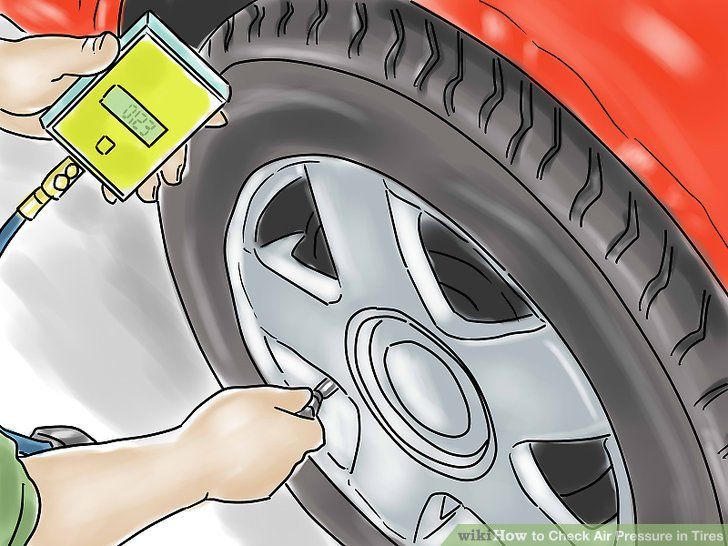 A poorly inflated tire, on the contrary, "sits" on the sidewalls, leaning on the shoulder areas of the tread and pushing the central part inward. Here's what it looks like:
A poorly inflated tire, on the contrary, "sits" on the sidewalls, leaning on the shoulder areas of the tread and pushing the central part inward. Here's what it looks like:
Both under-inflation and over-inflation in tires create many problems for the driver.
1. Increased wear of the central part of the tire tread.
2. Reduced ride comfort, hardness of potholes and road bumps.
3. Increased load on the car's suspension due to reduced tire damping effect.
4. Risk of tire damage and herniation due to shock loading (getting into a pit or pothole).
5. Reduced control stability due to reduced contact patch.
1. Increased wear of the tread sidewalls (shoulder areas).
2. Severe deformation of the rubber when driving over bumps, which increases the risk of tire damage.
3. An increase in tire temperature, which threatens to delamination of the carcass and can lead to tire explosion at high speed.
4. Increased risk of hydroplaning on wet roads.
5. Risk of tire breaking.
6. Increased fuel consumption.
Reduced pressure hits the driver's pocket hard: a pressure drop of 20% (which is not uncommon: it is enough, for example, to deflate the wheels to 1.8 atmospheres instead of the manufacturer's prescribed 2.2) reduces tire life by 25-30% and increases fuel consumption fuel by 3%.
There is no universal tire pressure: it depends on the size of the tires, the characteristics of the car (primarily weight) and road conditions. Therefore, it is important to follow the factory recommendations, maintaining exactly the tire pressure that the engineers expected when designing the car.
The recommended pressure for your machine can be found in the operating instructions and on the sticker in the door frame. If, depending on the configuration, tires of several dimensions were installed on the car, then the pressure recommended for them may differ - look in the table for your exact wheel size. The manufacturer may prescribe an increase in tire pressure at the maximum load of the machine. For the spare tire (Spare tire), the required pressure is also indicated on a separate line - note that it is much higher than the standard one.
The manufacturer may prescribe an increase in tire pressure at the maximum load of the machine. For the spare tire (Spare tire), the required pressure is also indicated on a separate line - note that it is much higher than the standard one.
So, you have found the necessary pressure parameters, it remains to decipher them. In physics, pressure is measured in pascals, in real life - in anything: in bars, atmospheres, pounds-force, kilogram-force ... Drivers and tire workers usually use the term atmosphere, but such a unit is often absent on pressure gauges (pressure measuring devices) . Let's clear up this confusion.
Atmosphere is a non-systemic unit of measurement, approximately equal to atmospheric pressure on the surface of the Earth. Since it has become widely used, it was necessary to somehow equate it with correct physical units. For simplicity, one atmosphere is considered equal to one bar, one kilogram-force and one hundred kilopascals.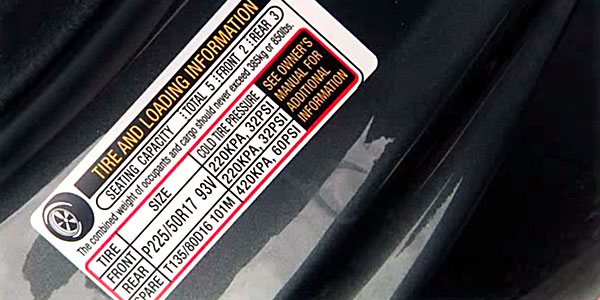
In addition to the technical atmosphere (at), there is also the physical atmosphere (atm), which is slightly larger. Again, for convenience, they are considered equal. But all these assumptions introduce an error, so if you need accurate tire pressure, measure it correctly - in pascals or bars. Moreover, manufacturers usually indicate the pressure in these quantities.
Imperial pounds-force (aka PSI, “psy”), popular in the USA, is more difficult to translate, here you can’t do without a calculator. In the table, we have collected together all pressure units with exact values, and also approximately brought them to each other to simplify calculations:
| Pressure units | |||||
| Pascal | Bar | Technical atmosphere | Physical atmosphere | PSI | |
| 1 Pa | 1 N/m² | 10-5 | 10. | 9.8692•10-6 | 145.04•10-6 |
| 1 bar | 105 | 1x106 dynes/cm² | 1.0197 | 0.98692 | 14.504 |
| 1 at | 98066.5 | 0.980665 | 1 kgf/cm² | 0.96784 | 14.223 |
| 1 bar | 101325 | 1.01325 | 1.033 | 1 bar | 14. |
| 1psi | 6894.76 | 68.948•10-3 | 70.307•10-3 | 68.046•10-3 | 1lbf/in² |
It is advisable to check tire pressure daily, before driving. But this is only possible with a very measured rhythm of life. In reality, checking at least once a month is already an excellent indicator for the average driver. But before traveling a long distance, checking the pressure and visual inspection of tires and rims should be done in any case.
It is necessary to measure the pressure in cold tires, that is, before driving. During driving, the tires heat up, which increases the pressure by about 10%. Therefore, never release supposedly excess air from hot tires: after cooling, the pressure will be below normal. If you had to inflate a hot tire during a trip, inflate it 10% more than the nominal value, and check the pressure again when the wheels have cooled down - no earlier than 3 hours after stopping.
If you had to inflate a hot tire during a trip, inflate it 10% more than the nominal value, and check the pressure again when the wheels have cooled down - no earlier than 3 hours after stopping.
Always check the pressure in all tires. Different tire pressures seriously affect handling and can cause the car to pull to the side. Do not forget about the "spare tire": it should always be inflated in case of an unexpected wheel change on the road.
For long-term driving at high speeds (more than 160 km/h), car manufacturers advise increasing tire pressure by 0.2-0.4 bar from the recommended value. This will slightly improve the handling of the car, although it will negatively affect comfort. But such advice is relevant for driving on high-speed autobahns, and not for everyday urban use, especially in Russia.
Before a long trip on a dirt road or a road with a muddy surface (mud, snow), it is reasonable, on the contrary, to reduce the pressure in the tires - this will improve the grip. In summer, it is worth limiting yourself to reducing pressure by 5-10% of the nominal value, and in winter - by 10-15%.
In summer, it is worth limiting yourself to reducing pressure by 5-10% of the nominal value, and in winter - by 10-15%.
The pressure in low-profile tires (especially non-standard sizes) must be monitored especially carefully. Low profile tires have two features: a low sidewall (profile) height and a large rim diameter. If the tire has the correct air pressure, only the tread is in contact with the road. Low pressure causes the sidewall of the tire to bend, causing it to touch the roadway and wear out quickly, up to complete abrasion. And punching a low-profile tire in a pit at low pressure is much easier.
When inflating low profile tires, you need to focus on the pressure indicated for a full load of the machine and the maximum allowable pressure for a particular tire. It is indicated on the sidewall, next to the inscription max pressure, in one of the accepted units of measurement: kilopascals (KPA), bars (BAR) or pounds-force (PSI).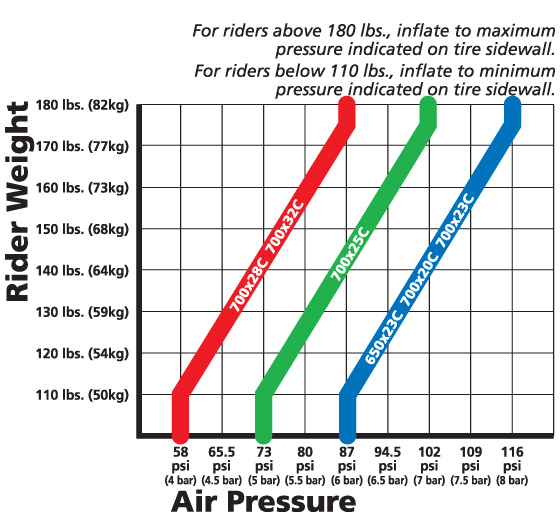
Modern cars equipped with sensors in tires and a TPMS (Tire pressure monitoring system) pressure monitoring system themselves monitor the pressure in each wheel and signal deviations, which is very convenient. If there is no such system in the car from the factory, you can install it yourself.
But the old manual measurement methods are still in use. Firstly, any modern car compressor is equipped with a pressure gauge: by inflating the wheel, you immediately control the pressure.
Secondly, there are compact hand-held pressure gauges: no need to unpack and connect the pump to check the pressure, and the measurement accuracy of such a pressure gauge is usually higher than that of a built-in compressor instrument. There are also modern digital pressure gauges on sale that allow you to switch pressure units on the fly and save readings in memory, which is very convenient.
Finally, if you want to entrust all maintenance of the car to professionals, you can use the services of tire fitting. In Hyperauto car services equipped with tire fitting areas, experienced mechanics will accurately measure and correct tire pressure, assess the condition of the tire tread and perform any other work with the wheels.
In Hyperauto car services equipped with tire fitting areas, experienced mechanics will accurately measure and correct tire pressure, assess the condition of the tire tread and perform any other work with the wheels.
What should be the pressure in the tires of the car? Does it need to be adjusted and what will happen if the pressure is changed in one direction or another?
- I have a wheel, I have a wheel!
— Absolutely?
— No, only from below…
Humor from the Net
Let's start with platitudes. The pressure must be as specified by the vehicle manufacturer. And since the average modern driver usually does not have such information, especially for him, a "cheat sheet" with the necessary numbers is hung on the middle pillar on the driver's side or on the gas tank hatch cover.
A relatively rare solution: the "reminder" is located on the gas tank flap.
A relatively rare solution: the "reminder" is located on the gas tank cap.
An important point: pressure should be measured only on cold tires. By the way, especially for pedants: cold tires are those on which the car has been without movement for at least 5 hours.
This "cheat sheet" nestled on the driver's door. An example of how tire pressure recommendations change depending on tire size.
This "cheat sheet" nestled on the driver's door. An example of how tire pressure recommendations change depending on tire size.
Since car manufacturers allow the use of tires of different sizes, the pressure may also be different. In addition, the pressure in the front and rear tires has the right to both differ and be the same.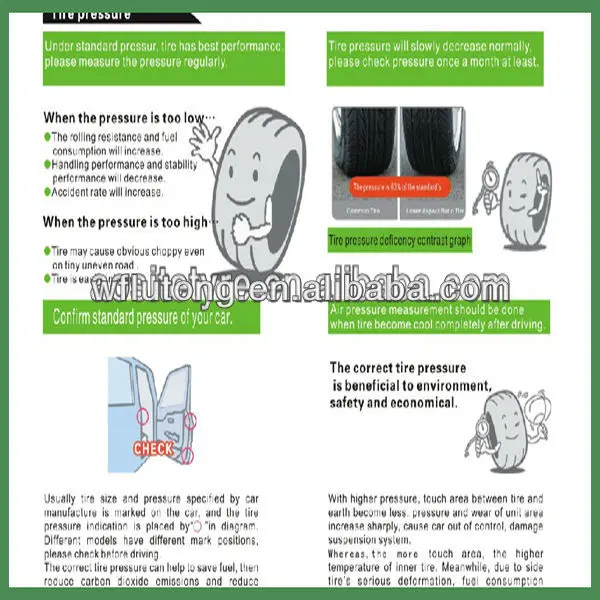
And there is no difference in the recommendations: what is in front, what is behind is the same.
And here there is no difference in recommendations: what is in front, what is behind is the same.
Related materials
Seasonal tire change: everything car owners need to know
Reduced pressure leads to an increase in tire deformation, its greater heating during wheel rolling, and accelerated wear of the outer tread tracks. Perhaps even a violation of the integrity of the frame. As a result, fuel consumption increases. If you hit a hole in the road, the likelihood of damage to both the disk and the tire is higher.
Increased pressure is an overstrain of the cords, increased wear of the middle part of the tread. In addition, when driving on a bad road, the shocks that are transmitted to the suspension and body will become more noticeable for riders. When hit in a pit, the likelihood of a tire burst increases.
When hit in a pit, the likelihood of a tire burst increases.
Uneven pressure on all four wheels is the worst thing! At the same time, the car, while driving, inevitably leads the wheels with lower pressure to the side - in fact, sideways movement begins.
Tube tires of the past required a weekly check, especially before the advent of butyl tubes. Then the pressure began to be checked less often, and nowadays, as a rule, they are limited to visual inspection.
Tube tires of the past required a weekly inspection, especially before the advent of butyl rubber tubes. Then the pressure began to be checked less often, and nowadays, as a rule, they are limited to visual inspection.
It's a good idea to check your tire pressure at least once a month. And before a long journey - just a must.
Related materials
Budget Tire Compressor Test: Wrong Bees
The air pressure in an enclosed space changes by approximately 0. 1 bar for every 10 degrees of temperature change. This allows, having installed summer wheels in April, not to worry about the pressure in them until the end of August, when the air temperature begins to drop. Having pumped up the wheels at the end of summer, you can already reach the seasonal shift. But having installed winter tires in October, with the first frosts, you should check the pressure a couple more times: when the temperature drops to minus ten, fifteen, and when it goes over minus twenty. But from the middle of winter until the moment of changing the wheels to summer ones, there is again a period of relaxation.
1 bar for every 10 degrees of temperature change. This allows, having installed summer wheels in April, not to worry about the pressure in them until the end of August, when the air temperature begins to drop. Having pumped up the wheels at the end of summer, you can already reach the seasonal shift. But having installed winter tires in October, with the first frosts, you should check the pressure a couple more times: when the temperature drops to minus ten, fifteen, and when it goes over minus twenty. But from the middle of winter until the moment of changing the wheels to summer ones, there is again a period of relaxation.
Electronics are increasingly thinking for us. Now, a tire pressure monitoring system is being installed on parts of production cars. Moreover, some simply read the wheel speeds through the ABS sensors: after all, a flat tire rotates faster, since its radius is smaller than that of inflated wheels. There are also sensors that evaluate the amount of air pressure and send information via radio to the "brains" of the car.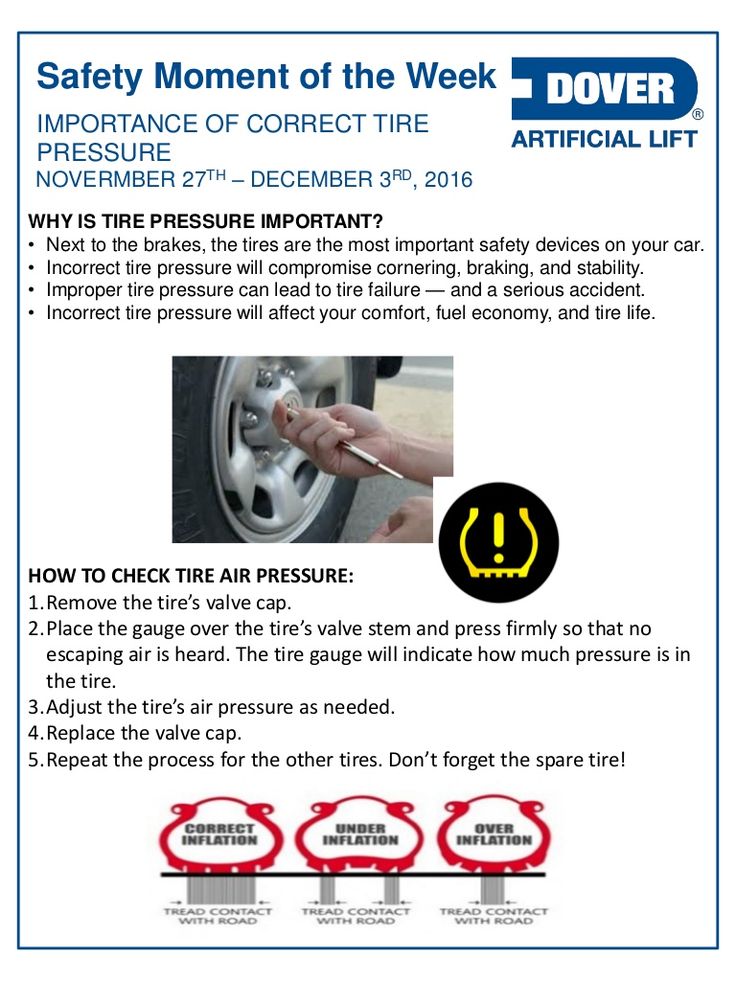 Such devices can also be purchased separately: sensors - in the wheels, and the receiver - in the car.
Such devices can also be purchased separately: sensors - in the wheels, and the receiver - in the car.
By the way, a lot depends on the road you are going to take.
The owner's manuals supplied with the vehicles indicate that it is recommended to increase the pressure by 0.2-0.3 bar before driving for a long time on expressways. We advise you to follow these recommendations on all cars: it will not get worse.
The operating instructions supplied with the vehicles state that it is recommended to increase the pressure by 0.2-0.3 bar before driving for a long time on highways. We advise you to follow these recommendations on all cars: it will not get worse.
I don’t want to discuss overload: this, you see, is not the case. But, unfortunately, many deliberately overload the car several times a year, not only stuffing the interior and trunk to the eyeballs, but also attaching a trailer, which additionally loads the rear wheels of the tractor. In such cases, we advise you to increase the pressure in the rear tires by at least 0.2–0.3 bar. Tires will only thank you.
In such cases, we advise you to increase the pressure in the rear tires by at least 0.2–0.3 bar. Tires will only thank you.
If you doubt the accuracy of your pressure gauge, then we advise you to check it immediately after leaving the tire shop, where you were set the obviously necessary pressure, to measure it with your own measuring device (separate or as part of the compressor). So you determine whether your pressure gauge is "lying" a lot. For the future, right on the dial, you can put a mark of the correct value.
Of course, it is better to have your own, known to be correct pressure gauge, but such a toy is not cheap.
Of course, it is better to have your own, known to be correct pressure gauge, but such a toy is not cheap.
If terrible ice caught you on summer tires, say, in the country, and you need to drive some distance along an absolutely icy road by any means, then you should reduce the tire pressure to approximately 1. 6 bar. Is it bad for tires? Yes. But an accident will cost more. In addition, in such a situation, one does not have to wait for high speed, and overheating of tires at near-zero temperatures most likely will not happen.
6 bar. Is it bad for tires? Yes. But an accident will cost more. In addition, in such a situation, one does not have to wait for high speed, and overheating of tires at near-zero temperatures most likely will not happen.
Everyone knows what caused the excellent maneuverability of Soviet tanks? That's right: wide tracks, that is, low pressure on the ground. We, having an ordinary, non-all-wheel drive car, are also able to provide it with a similar cross-country ability. If the wheels of the car sink into sand, snow or sticky mud, then it makes sense to lower the tire pressure. And not only driving, but also driven wheels.
We know from experience that it is often possible to get out of the "black spot" by reducing the pressure to 1.2 bar.
We know from experience that it is often possible to get out of the "black hole" by reducing the pressure to 1.2 bar.
In a very critical situation, if you know that you have a fairly narrow disc and a relatively wide tire (such a wheel has a lower chance of self-disassembly), you can reduce the pressure to 1. 0 bar.
0 bar.
Stalled on wet grass? Try to relieve pressure.
Stalled on wet grass? Try to relieve pressure.
Pressure reduction is also useful in other cases - for example, to overcome diagonal hanging. If you reduce the pressure in the wheels on which the car rests, their height will decrease and there will be a chance to “hook” on the suspended wheels. Of course, if the car has already laid down on the bottom, then it is too late to reduce the pressure - this will only interfere.
A concrete example of the effect of pressure on flotation. In this case, the pressure is very low, and the contact patch of the wheel with the coating is much larger than that of a conventional car.
A concrete example of the effect of pressure on patency. In this case, the pressure is very low, and the contact patch of the wheel with the coating is much larger than that of a conventional car.